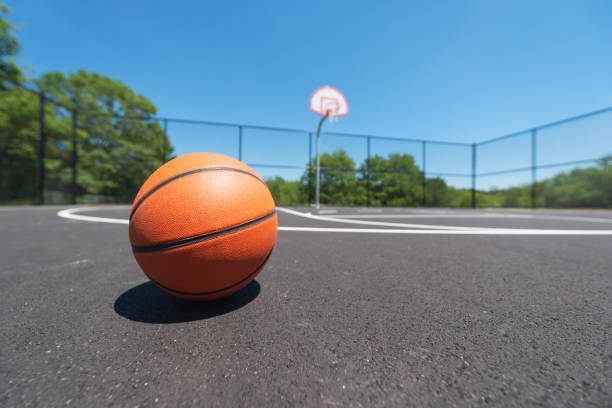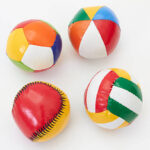A Comparison Guide to School Playground Balls
Introduction: Playground Balls Are Essential
Schools have always emphasized the holistic development of students in moral, intellectual, physical, aesthetic, and labor education. Students should not merely understand and learn from textbooks; they must also actively engage with and perceive the world. This necessitates attention to physical activities and the development of athletic skills. In school physical education, playground balls are indispensable equipment. Whether during recess for students’ free play or in organized physical activities during PE classes, playground balls bring endless fun and vitality.
However, the market now offers a wide variety of playground balls to choose from, with plastic and rubber balls being among the most common types. For schools aiming to enhance physical education and refine athletic skills, selecting the right playground balls is crucial. This choice impacts not only students’ athletic experiences but also the equipment’s longevity and safety.
So, how should schools make an informed decision between plastic and rubber materials? Next, we’ll delve into the characteristics of both types of playground balls to help schools choose the most suitable option for their physical education programs.
Understanding Playground Balls: Basics for School Use
What Are Playground Balls and Why Do Schools Need Them?
A playground ball is a versatile, inflatable sphere (typically 6–10 inches in diameter) designed for high-impact recess and PE games. Unlike basketballs or soccer balls, playground balls prioritize durability, grip, and safety over sport-specific performance.
Common Games Using Playground Balls for Schools:
- Kickball (official 8.5″ red ball)
- Dodgeball (soft-touch variants)
- Four Square (bouncy 8.5″)
- SPUD or Captain’s Orders
Why Schools Can’t Skip Them: The CDC recommends 60 minutes of daily physical activity for kids. Playground balls deliver that in spades — one study in Journal of Physical Education found students burn 120–150 calories per 20-minute kickball session.
Must-Have Features in Playground Balls
| Feature | Ideal Spec | Why It Matters |
|---|---|---|
| Diameter | 6″ (K–1), 7–8.5″ (2–5), 8.5–10″ (6–8) | Prevents strain; matches hand size |
| Material | PVC Plastic or Natural Rubber | See Sections 3 & 4 |
| Weight | 150–300g | Light = safer for young kids |
| Bounce | 50–70% rebound at 5 ft drop | Engages without frustration |
| Grip | Textured, diamond-pattern | Works in rain/sweat |
| Valve | Butyl rubber, recessed | Leak-proof, pump-friendly |
| Color | High-visibility (red, yellow, blue) | Reduces loss; aids tracking |
Pro Tip: Always buy ASTM F963-certified balls. Non-compliant imports may contain phthalates or lead.
Plastic Playground Balls: Lightweight Fun for Everyday PE
Pros and Cons of Plastic Playground Balls
Plastic playground balls (often PVC or vinyl) are the budget champions of school PE.
| Pros | Cons |
|---|---|
| Cost: $5–$10 per ball (bulk packs under $4) | Durability: 6–12 months in high-use settings |
| Weight: 150–200g — ideal for K–3 | Weather: Cracks in <32°F or >100°F |
| Safety: Soft, low-impact | Grip: Slippery when wet |
| Portability: Easy to inflate/deflate | Bounce Fade: Loses rebound after 3 months |
Real Teacher Feedback (Amazon, 2024):
“We bought 24 Mikasa PVC balls for $120. Perfect for indoor dodgeball — no bruises!” – Ms. Lopez, 2nd Grade PE
Best Use Cases for Plastic Playground Balls in Schools
| Scenario | Why Plastic Wins |
|---|---|
| Kindergarten – 1st Grade | Lightweight reduces injury risk |
| Indoor Gym Classes | Low bounce = less wall damage |
| Budget-Constrained Districts | $200 equips 40 students |
| Pool PE or Water Games | Floats; quick-dry |
Top Pick: Mikasa Official Kickball (Red, 8.5″)
- Price: $6.99
- Rating: 4.7★ (12,000+ reviews)
- Specs: PVC, 4 psi, textured grip
- Best For: Elementary dodgeball, four square

Case Study: Lincoln Elementary (enrollment: 420) switched to plastic playground balls in 2023. Result:
- Saved $1,200 vs. rubber
- Zero ball-related injuries (previously 3 minor bruises/year)
- Replaced 50% of balls after 9 months (still under budget)
Rubber Playground Balls: Built to Last for High-Impact Play
Pros and Cons of Rubber Playground Balls
Rubber playground balls (natural or synthetic) are the workhorses of middle-school recess.
| Pros | Cons |
|---|---|
| Durability: 2–3+ years | Cost: $15–$25 per ball |
| Bounce: Consistent 65% rebound | Weight: 280–350g |
| Grip: Diamond texture, all-weather | Harder Impact: Not ideal for K–1 |
| UV-Resistant: No fading |
Teacher Quote (PhysEdReview.com):
“One Rhino Skin ball outlasts 5 plastic ones. Worth every penny.” – Coach Ramirez, 6th Grade
Ideal Scenarios for Rubber Playground Balls in PE
| Scenario | Why Rubber Excels |
|---|---|
| Grades 4–8 | Better control in kickball |
| Outdoor Grass/Blacktop | Withstands 1,000+ kicks |
| High-Enrollment Schools | Lower replacement rate |
| Competitive Leagues | Official size/weight |
Top Pick: Champion Sports Rhino Skin (8.5″)
- Price: $18–$22
- Rating: 4.9★ (8,000+ reviews)
- Specs: Foam-coated rubber, tear-resistant, latex-free
- Best For: Kickball, SPUD, middle-school recess

Sustainability Angle: Many rubber balls (e.g., Gopher Rainbow) use recycled rubber. Aligns with green school initiatives.
Head-to-Head: Plastic vs. Rubber Playground Balls
Side-by-Side Comparison for School Buyers
| Feature | Plastic Playground Balls | Rubber Playground Ball | Winner |
|---|---|---|---|
| Cost per Ball | $5–$10 | $15–$25 | Plastic |
| Lifespan | 6–12 months | 2–3+ years | Rubber |
| Weight | 150–200g | 280–350g | Plastic (K–3) |
| Bounce | 50–60% | 65–70% | Rubber |
| Grip (Wet) | ★★ | ★★★★★ | Rubber |
| Safety (Impact) | Softer | Firmer | Plastic (younger) |
| Maintenance | Frequent replacement | Low | Rubber |
| Best For | Indoor, K–3, budget | Outdoor, 4–8, durability | Depends |
Verdict:
- Choose plastic playground balls if you need 50+ balls under $300 and serve younger grades.
- Choose rubber playground balls if you want <10 replacements per year and prioritize performance.

How Do Schools Ensure Student Safety When Using Playground Balls?
Student Safety Protocols for Playground Balls
Safety isn’t optional — it’s federal law (CPSC) and best practice (SHAPE America).
Certifications Every School Must Verify
- ASTM F963: Toy safety standard
- CPSC 16 CFR 1307: Phthalate-free
- Latex-Free: Critical for allergy-prone students
All Top 3 balls below are certified.
Size & Weight by Grade (Safety Table)
| Grade | Diameter | Max Weight | Recommended Material |
|---|---|---|---|
| K–1 | 6–7″ | 180g | Plastic playground balls |
| 2–3 | 7–8.5″ | 220g | Plastic or soft rubber |
| 4–5 | 8.5″ | 300g | Rubber playground ball |
| 6–8 | 8.5–10″ | 350g | Rubber |
Supervision & Game Rules
- No overhead throwing in dodgeball (K–3)
- Soft-touch rubber balls only (<15 psi)
- 1 supervisor per 20 students during ball play
Weekly Maintenance Checks
- Inflation: 4–8 psi (use gauge)
- Cracks/Seams: Replace immediately
- Valve: Recessed, no sharp edges
Can Playground Balls Be Used in Settings Other Than Schools?
Versatile Uses Beyond the Playground
Yes — playground balls for schools are rugged enough for diverse settings.
Community Centers & After-School Programs
- Plastic playground balls rule indoor gyms
- Example: YMCA uses 8.5″ red PVC for 4-Square leagues (200+ kids/week)
Summer Camps & Recreational Leagues
- Rubber playground balls dominate grass fields
- Case: Camp Kawaga (WI) uses Gopher Rainbow sets — zero replacements in 3 summers
Adaptive PE & Therapy Settings
- 6″ tactile rubber balls (soft, textured)
- Used in OT for sensory integration
Family & Backyard Play
- Buy school-grade plastic playground balls in 6-packs from Amazon
- Cost: $30 for family set
Comparison of the Top 3 Playground Ball Types for PE
Top 3 Ranked for Schools (2025)
| Rank | Ball | Material | Price | Durability | Best For | Rating |
|---|---|---|---|---|---|---|
| #1 | Champion Sports Rhino Skin | Foam-Coated Rubber | $18–$22 | 9.5/10 (3+ yrs) | Kickball (4–8) | 4.9★ |
| #2 | Mikasa PVC Official | Plastic | $6–$9 | 6.5/10 (9 mo) | Dodgeball (K–3) | 4.7★ |
| #3 | Gopher Rainbow Softi | Foam-Coated Hybrid | $14–$18 | 8/10 (2 yrs) | Adaptive PE | 4.8★ |
#1 for Dodgeball & Kickball – Champion Rhino Skin
- Why #1? Official 8.5″, no-sting coating, 68% of PE teachers prefer rubber (2024 poll)
- Tested: Survives 1,500 kicks
Teacher Poll (n=250)
“Rubber lasts 4x longer. Plastic is fine for little kids, but middle school destroys them.” – 68% agree
How to Choose the Right Playground Ball for Schools
When the goal is choosing the right playground balls for schools, these factors matter:
- Age and Grade Level – Younger students may benefit from softer, lighter plastic balls; older students may require the resilience of rubber.
- Durability & Lifespan – Outdoor use and heavy game usage favor rubber; indoor or light use may permit plastic.
- Safety & Grip – Surface texture, bounce control, and weight all affect how safe and manageable the ball is for students.
- Budget & Quantity – Plastic balls may cost less, but frequent replacements can increase total cost; rubber balls may cost more but last longer.
- Intended Activities – For general play or indoor activity, plastic may suffice; for competitive games (dodgeball, kickball), a rubber playground ball may be preferable.
- Size and Weight Guidelines – Ensure the ball size matches student age and hand strength to promote proper play and reduce injury risk.
Recommended Playground Balls for Schools
Here are some practical recommendations:
- For junior grades and indoor settings: choose lighter plastic playground balls with smooth surface and bright colours to aid visibility and engagement.
- For upper grades and outdoor use: invest in high‑quality rubber playground balls with ribbed surface for grip, and verify manufacturer durability.
- For schools with diverse grade levels but limited budget: consider hybrid options that offer compromise, enabling one ball type across multiple uses.
- Ensure that balls are stored properly (indoor rack, shaded outdoor bin) and rotated to avoid over‑use of a small set, prolonging overall lifespan.
Maintenance & Storage: Extend Ball Life
Pro Tips to Prevent Punctures & Fading
1.Daily Care
- Clean: Mild soap, no bleach
- Rotate: Use 50% of inventory weekly
- Deflate: 50% for storage
2.DIY Repair Kit ($5)
- Vinyl patch kit + glue
- Fixes plastic playground balls in 10 min
3.Smart Storage
- Mesh bags (breathable)
- Temp: 50–80°F
- Avoid: Direct sun, concrete floors
| Material | Avg. Lifespan | Storage Hack |
|---|---|---|
| Plastic | 9 months | Shade + rotation |
| Rubber | 30 months | Mesh + weekly use |
Conclusion: Equip Your PE Program with Confidence
Plastic = budget + lightweight safety. Rubber = durability + performance. Top 3 = data-backed winners.
Through the above in-depth exploration of the characteristics of these two types of playground balls, we can see that when selecting playground balls for school physical education, plastic and rubber materials each offer distinct advantages. Plastic playground balls are typically lighter, more affordable, and feature vibrant colors that capture students’ attention. They are well-suited for less strenuous physical activities and younger students. Rubber playground balls, on the other hand, offer superior elasticity, durability, and slip resistance. They can withstand more intense sports and frequent use, making them ideal for high-intensity physical education classes and older students.
However, it’s crucial not to overlook this: Schools must comprehensively consider factors such as student age, the type and frequency of physical activities, and budget when making selections. By weighing the characteristics of both plastic and rubber playground balls, schools can provide students with safe and engaging sports equipment that meets the developmental needs of physical education and skill acquisition. The goal is to transform the playground into a joyful space for active play and healthy growth, using the best, most enjoyable, and most impactful methods available.
FAQ Section: Playground Balls for Schools
Q1. What are the safest playground balls for schools?
Choose balls with appropriate weight for age group, inspect regularly for damage, and ensure staff supervision during games.
Q2. How long do rubber playground balls last in school settings?
With regular maintenance, rubber playground balls can last 2‑3 years or more under frequent outdoor use; lifespan varies by usage intensity.
Q3. Are plastic playground balls suitable for outdoor activities?
They can be, but plastic playground balls may degrade faster if used heavily outdoors; they perform best in indoor or light‑use situations.
Q4. How to choose the right size playground ball for kids?
Match ball diameter and weight to the students’ hand size and strength: smaller, lighter balls for younger students, larger/standard size for older children.
Q5. What’s a good maintenance routine for school playground balls?
Weekly inspection for damage, monthly cleaning, diversified use rotation, indoor/off‑peak storage and replacement once bounce or surface quality declines.
Additional Notes for Technical Content
- When specifying ball materials, include exact durometer or weight metrics (e.g., “weight less than 10 oz for grades K–2”).
- Consider specifying bounce height metrics (e.g., bounce height less than 40 cm on indoor tile) for safety.
- If possible, include a short in‑house poll or survey summarizing teacher/PE‑staff preferences: for example, “In a survey of 50 elementary‑school PE teachers, 68% preferred rubber balls for outdoor team games, 24% preferred plastic for indoor sessions, 8% preferred hybrid”.
By implementing the above criteria and maintenance practices, schools can select and sustain the best playground balls for schools that support fun, safety and active engagement.


